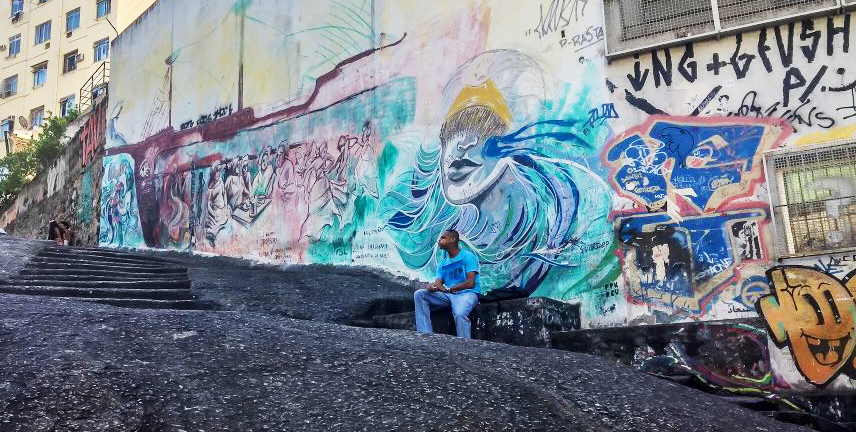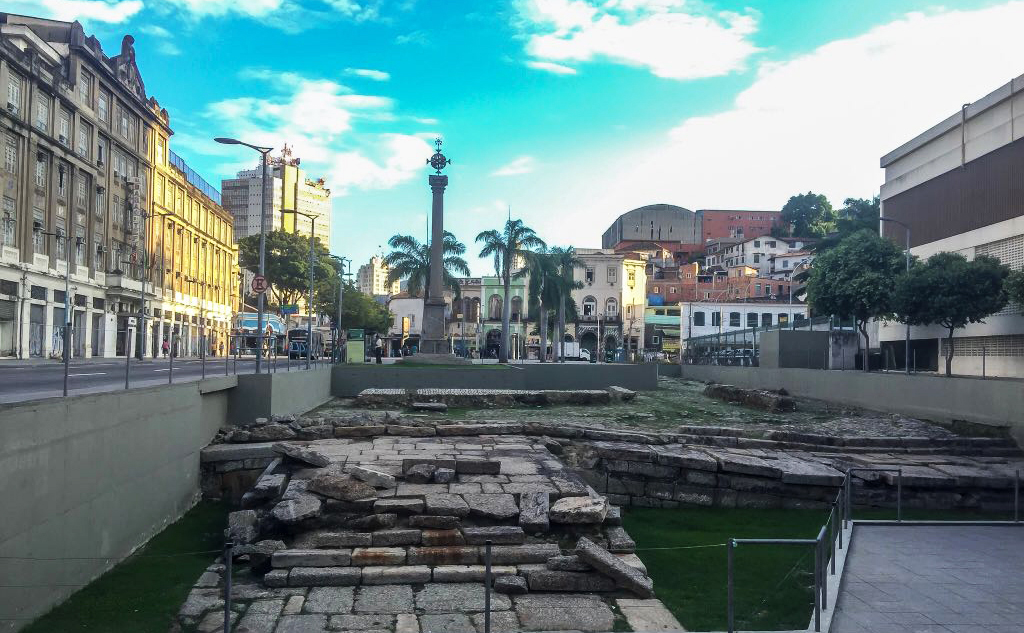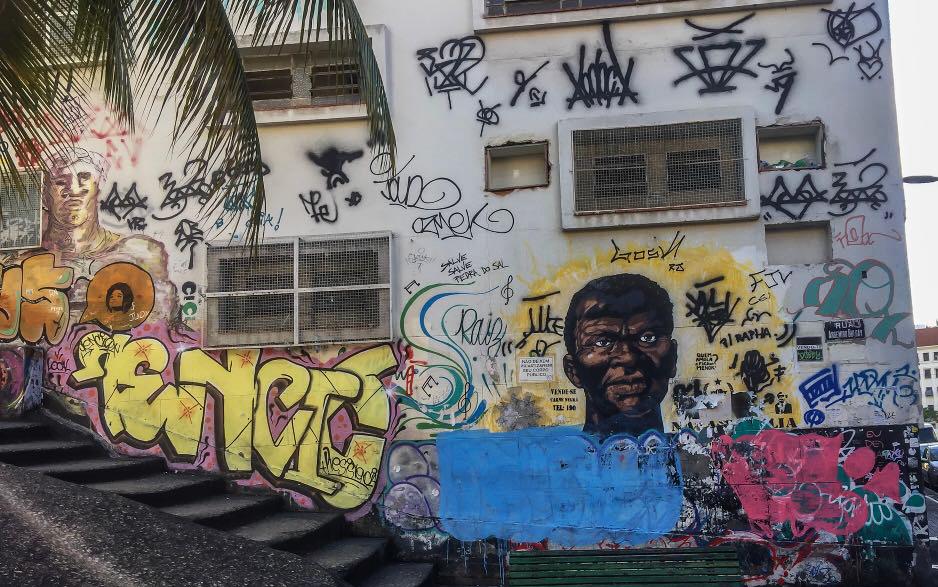RIO DE JANEIRO — Standing on the rooftop of the five-storey Museum of Art (MAR), I have an aerial view of the Praça Mauá square in the heart of this playful Brazilian city. Below me, the wide public space is bordered by Guanabara Bay, a deep blue body of water dotted with yachts and framed by the Niteroi bridge in the horizon. The Museum of Tomorrow stands between the bay and the square, enticing intrigued tourists to take photos of its futuristic architecture before venturing inside to learn about climate change and the Earth’s future. Slim palm trees with broad leaves line the pale stone plaza, a hint of Brazil breaking up the square’s European design.
“It’s here the name Little Africa was born,” says Gabriela Palma, my tour guide. I’m here in the city’s downtown to learn about Rio de Janeiro’s past slave trade. More than five million slaves were brought to Brazil – that’s about 10 times more than sent to the U.S. – from the 16th century until 1888 when slavery was abolished. It has been one of the most influential events in Brazil’s history, yet it’s rarely talked about.
Nowadays, Praça Mauá is a popular tourist destination, yet just over 100 years after slavery ended, the scene in this square told a different story. With no money and no home, thousands of freed slaves banded together in this region, planning their next move in a haze of uncertainty.

Above: Murals tells the story of Rio's ugly involvement in the slave trade.
“Locals heard them talking in different African languages. They called the area Little Africa as it seemed like a mini-version of the continent,” Gabriela explains. The name stuck and today the region is home to the oldest Afro-Brazilian population in Rio.
Rio de Janeiro accounted for two million enslaved Africans and the rest went to other coastal cities, mainly Salvador in Bahia. Many of Rio’s defining features from samba and Carnival to its ethnic diversity and cuisine comes from the traditions of the African people.
With Gabriela as my guide, I walk down into the square and head into Rio’s city centre, making a quick detour to Olympic Blvd. next to Praça Mauá to see the world’s largest street mural designed by São Paulo-born Eduardo Kobra in 2016. At 15 metres tall and 170 metres long, the masterpiece is made up of five portraits of indigenous people representing Europe, Asia, Africa, the Americas and Australasia, and mixes photorealism with geometric patterns in an explosion of colour and culture.
We head further into the city centre. At the end of a walkway, we come across a cornered-off platform built from large grey slabs of rock forming the outline of a former port from the early 18th century. Known as the Valongo Wharf, it was built so the wealthy residents that lived at the top of nearby Conceição hill didn’t have to see the estimated one million slaves that came through this port. Looking at it now, surrounded by office blocks with white-collared workers in smart suits hurrying past, it’s hard to picture its past. Now it’s remembered as a UNESCO World Heritage Site as a reference to its importance in Brazilian history.

Above: Valongo Warf was built so the rich people of Rio would not see the slaves being offloaded.
We move from the wharf and head to The Research Institute and Memorial of the New Blacks, a small museum that plays a big role in preserving the memory of those brought to Brazil. Displays mounted on the wall explain the journey from Africa to Brazil and into slavery. Images of former slaves hang from the ceiling. A wall at the back of the museum is covered in the names of those enslaved in this period of history. The most poignant of all is the burial ground where an estimated 30,000 bodies of those who died during the journey from Africa to Brazil are buried. Beneath a glass pyramid case, bones peak through the soil serving as a sobering reminder of the past’s harsh realities.
Back outside the museum, Gabriela takes me to Pedra do Sal (Salt Rock) a name coined from when the slaves were forced to break huge chunks of salt on the large rocky platform there. Gabriela explains that after slavery was abolished, Pedra do Sal became the residence of the first quilombos, the communities of freed slaves who sought shelter there. It was these groups that made the first samba songs and turned Pedra do Sal into the birthplace of samba.

.jpeg)
Above: The back streets take you on a journey back in time to when the slaves first arrived.
Today, Pedra do Sal’s name has become associated with Rio’s largest and most famous live samba party that takes place in the cobblestone backstreets of Gamboa every Monday and Friday night. Live bands — known as roda de samba – fill the air with the hypnotic beats of the iconic Brazilian genre while a mix of locals and tourists gather to drink potent caipirinhas and dance until dawn.
If the heart of Rio is in its downtown, it’s here in Pedra do Sal where you’ll find its soul.
INFORMATION:
Where to eat
• Angu do Gomes: A low-key restaurant in the city centre, Angu do Gomes is famous for its classic Brazilian cuisine and cold beers. Try the angu, an Afro-Brazilian dish made with corn flour and served with cuts of meat in a rich sauce. http://www.angudogomes.com.br/
• Bodega do Sal: A participant in the Comida di Buteco, a competition in Brazil that searches for the best bar snacks in the country, Bodega do Sal is a traditional Brazilian pub next to Pedra do Sal. Try their competing dish, the deep-fried sardine coquettes with a coriander pesto. http://botequimbodegadosal.com.br/
• Imaculada: Off the main road in the city centre, even taxi drivers haven’t heard of Imaculada, yet that doesn’t stop it from filling up every evening. The star of the menu is the roasted ox tongue with potatoes and farofa (fried cassava flour). http://www.barimaculada.com.br/
Guide
• For a guided tour of the Little Africa region and to learn about its history, Sou + Carioca provides both Portuguese and English tours. My tour was with Gabriela Palma. https://www.facebook.com/soumaiscarioca/
Attractions
• The city centre has plenty of attractions to see and you can easily spend a couple of days exploring the area.
• The Museum of Tomorrow: The museum is just as famous for its futuristic style architecture as it is for its contents. The striking elongated roof is the design of Spanish architect Santiago Calatrava and the museum uses interactive displays to discuss climate change and the future of our planet.
https://museudoamanha.org.br/en
• The Museum of Art (MAR): Holding some of Brazil’s most important artworks, the Museum of Art features collections from both Brazilian and international artists dating back from the colonial era to the present day.
http://www.museudeartedorio.org.br/en
• The Research Institute and Memorial of the New Blacks: The memorial preserves the history of slavery in Brazil and is the final resting ground of approximately 30,000 enslaved Africans.
http://www.museusdorio.com.br/joomla/index.php?option=com_k2&view=item&id=107:memorial-dos-pretos-novos-the-memorial-of-the-new-blacks
• Churches: Standing the test of time are the early 17th-century Sao Francisco da Prainha church and the mid-18th century Nossa Senhora de Saude church.
• AquaRio: One of the largest aquariums in South America, the AquaRio features a long aquarium tunnel where visitors can walk through and get up-close-and-personal with a variety of marine creatures. Its interactive and informative displays make it ideal for an educational activity for kids.
http://www.aquariomarinhodorio.com.br/
• Lapa: Known as Rio’s nightlife district, the neighbourhood is packed with late-night bars, typical Brazilian restaurants and lively dance clubs.
• Selarón steps: The bright-coloured staircase is a handmade mosaic created by Chilean-born Jorge Selarón, who dedicated his work to Brazil after declaring the country his second home.
Tourism info: http://visit.rio/en/welcome/